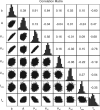A new framework for modeling decisions about changing information: The Piecewise Linear Ballistic Accumulator model
- PMID: 26760448
- PMCID: PMC4874184
- DOI: 10.1016/j.cogpsych.2015.11.002
A new framework for modeling decisions about changing information: The Piecewise Linear Ballistic Accumulator model
Abstract
In the real world, decision making processes must be able to integrate non-stationary information that changes systematically while the decision is in progress. Although theories of decision making have traditionally been applied to paradigms with stationary information, non-stationary stimuli are now of increasing theoretical interest. We use a random-dot motion paradigm along with cognitive modeling to investigate how the decision process is updated when a stimulus changes. Participants viewed a cloud of moving dots, where the motion switched directions midway through some trials, and were asked to determine the direction of motion. Behavioral results revealed a strong delay effect: after presentation of the initial motion direction there is a substantial time delay before the changed motion information is integrated into the decision process. To further investigate the underlying changes in the decision process, we developed a Piecewise Linear Ballistic Accumulator model (PLBA). The PLBA is efficient to simulate, enabling it to be fit to participant choice and response-time distribution data in a hierarchal modeling framework using a non-parametric approximate Bayesian algorithm. Consistent with behavioral results, PLBA fits confirmed the presence of a long delay between presentation and integration of new stimulus information, but did not support increased response caution in reaction to the change. We also found the decision process was not veridical, as symmetric stimulus change had an asymmetric effect on the rate of evidence accumulation. Thus, the perceptual decision process was slow to react to, and underestimated, new contrary motion information.
Keywords: Evidence accumulation models; Hierarchal Bayesian inference; Non-stationary stimuli; Random-dot motion.
Copyright © 2015 Elsevier Inc. All rights reserved.
Figures







References
-
- Anstis S, Verstraten FA, Mather G. The motion aftereffect. Trends in Cognitive Sciences. 1998;2(3):111–117. - PubMed
-
- Atkinson KA. An introduction to numerical analysis. 2nd ed. John Wiley & Sons; 1989.
-
- Ball K, Sekuler R. A specific and enduring improvement in visual motion discrimination. Science. 1982;218(4573):697–698. - PubMed
-
- Botvinick MM, Braver TS, Barch DM, Carter CS, Cohen JD. Conflict monitoring and cognitive control. Psychological Review. 2001;108:624–652. - PubMed
MeSH terms
Grants and funding
LinkOut - more resources
Full Text Sources
Other Literature Sources

